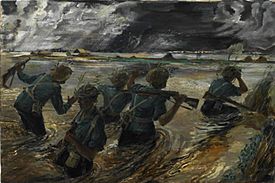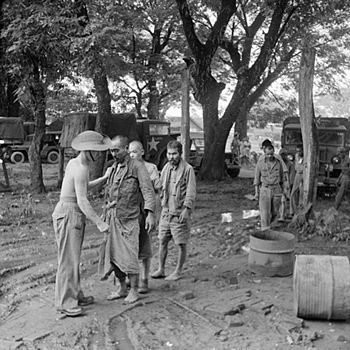Battle of the Sittang Bend facts for kids
Quick facts for kids Battle of the Sittang Bend |
|||||||
|---|---|---|---|---|---|---|---|
| Part of the Burma Campaign of World War II | |||||||
 5.5-inch guns of the Royal Artillery firing on Japanese troops attempting to break out of the Sittang Bend in early August 1945 |
|||||||
|
|||||||
| Belligerents | |||||||
| Commanders and leaders | |||||||
| Strength | |||||||
|
|
|||||||
| Casualties and losses | |||||||
|
Total: 2,000
|
Total: 14,000
|
||||||
The Battle of the Sittang Bend was a major military event near the end of World War II. It happened in Burma, a country in Southeast Asia. This battle involved Japanese soldiers trying to escape from British forces. They were trapped in a hilly area called the Pegu Yoma. Their goal was to cross the Sittang River and join other Japanese troops.
The Japanese Twenty-Eighth Army led this escape attempt. Other Japanese armies, the Thirty-Third Army and Fifteenth Army, tried to help. The British knew about the Japanese plan. They set up strong defenses, causing huge losses for the Japanese. This battle was the last major land fight for Western countries in World War II.
Around 14,000 Japanese soldiers were lost, with over half of them killed. The British forces had far fewer losses, with 95 killed and 322 wounded.
Contents
Why the Battle Happened
Setting the Scene in Burma
By early 1944, British forces in India were much stronger. They had more supplies and were ready to attack into Burma. The Japanese tried to stop them by invading India. This plan, called Operation U-Go, failed badly for Japan. They also faced other defeats in Northern Burma.
Later, the Japanese lost another big battle at Meiktila and Mandalay. This made it even harder for them to defend Burma. The Burmese National Army also changed sides. They began fighting against the Japanese.
British Advance and Japanese Retreat
In April, British and Indian troops moved quickly. They traveled about 300 miles (480 km) down the Sittang River valley. Japanese soldiers tried to slow them down. But on May 2, the city of Rangoon fell to Allied forces. This was a landing by sea called Operation Dracula. A few days later, British troops from the land and sea met up.
After Rangoon fell, the main British command moved. A new group, the Twelfth Army, took over in Burma. They commanded the troops in the Sittang valley.
Japanese Trapped
The Japanese Twenty-Eighth Army had retreated. They were stuck in the Pegu Yomas. This is a range of low mountains between two rivers. Other Japanese units joined them there. These soldiers were from different groups.
The Japanese troops in the Pegu Yomas planned to break out. They wanted to cross the Sittang River. Then they hoped to reach Thailand. The Sittang River was very wide and deep. It was a big barrier, just like in an earlier battle in 1942. The Japanese commander, General Heitarō Kimura, ordered another army to help. The Thirty-Third Army was to attack to distract the British. This would allow the Twenty-Eighth Army to escape.
The Battle Unfolds
British Get the Plan
British spies knew the Japanese planned to break out. But they didn't have all the details. So, the British commander, General Montagu Stopford, spread his troops out. They covered over a hundred miles to block the Japanese.
On July 2, 1945, a Gurkha patrol found something important. They captured a Japanese bag with the full escape plan inside. The British now knew exactly what the Japanese would do. They had two weeks to get ready. One of the Japanese escape routes went right through a British base. This area was quickly reinforced with more troops.
Japanese Plan to Break Out
The Japanese planned to move in three groups. They had strict rules: no shooting, only bayonets. They also couldn't use radios. They would cross the Sittang River on rafts made of bamboo. The Japanese commander thought he could get half his troops across. But he didn't know how strong the British defenses were.
First Attack: The Diversion
The Japanese Thirty-Third Army attacked the Sittang Bend on July 3, 1945. This was meant to help the Twenty-Eighth Army escape. But the attack happened too early. It was a week before the main escape attempt.
The British let the Japanese advance. They didn't know their plans were already known. Then, when many Japanese troops were in the open, the British attacked. Shells and bombs rained down. British artillery officers watched Japanese movements. They called in constant artillery fire.
The Royal Air Force also attacked from the sky. Spitfires and Thunderbolts bombed Japanese targets. On July 4, three large Japanese guns were destroyed by Thunderbolts. This showed how powerful air support was.
By July 7, the Japanese Thirty-Third Army had lost many soldiers. Their commander ordered them to stop. He hoped this would still help the Twenty-Eighth Army. But the British knew everything. They simply focused on the main escape route.
The Main Breakout Battle
On July 15, the Japanese Twenty-Eighth Army began its escape. They didn't know the British knew their plans. The rainy season, called the monsoon, had started. The British set up two "killing fields." The first used artillery to target twelve Japanese crossing points. The second used aircraft to attack anyone who crossed the road. Even in bad weather, planes could fly.
British observers on the ground and in the air guided the attacks. Tanks and infantry covered gaps between positions. Burmese forces waited on the other side of the river. They would deal with any Japanese who made it across.
The Japanese 55th Division ran right into a strong British position. Tanks and infantry fought back every attack. The Japanese suffered huge losses. British artillery kept firing on Japanese survivors. It was a very unequal fight. The RAF also attacked Japanese groups and boats. Many Japanese soldiers were killed by air attacks. One Japanese unit of 600 men tried to escape separately. Only a few survived.
On July 21, the Japanese made their last, desperate attempt. About 10,000 soldiers, many sick, tried to cross the Sittang. The 54th Division had many sick soldiers. They crossed flooded fields towards the river. The Allies used every tank, gun, and machine gun against them. Even in bad weather, planes flew. Thunderbolts and Spitfires dropped bombs. These bombs caused terrible damage to the Japanese.
British ground observers sometimes got too close to the action. They were even wounded by bombs from their own planes. British guns, especially the large 5.5-inch and 4.5-inch guns, shelled the routes. The Japanese were slaughtered. This continued until the end of July.
-
A Supermarine Spitfire Mark VIII of No 607 Squadron is prepared by an RAF crew during monsoon conditions at Mingaladon for a sortie against the Japanese break-out attempt at Sittang
Final Efforts
By July 28, the last Japanese attack was stopped. The Japanese Fifteenth Army tried to help the remaining soldiers. Karen fighters, who were local guerrillas, ambushed hundreds of Japanese. They also attacked parts of the Fifteenth Army. A special Allied group, Force 136, worked with the Karen fighters. They used small planes to rescue wounded soldiers and bring supplies. They also helped guide air attacks.
By July 29, the Fifteenth Army gave up. They realized the escape was a disaster. Only a few Japanese units made it across the Sittang River. The fighting ended by August 7.
What Happened After
The Japanese escape attempt failed completely. It greatly lowered their spirits. The remaining Japanese soldiers were constantly attacked by Karen fighters and the RAF. British commanders called the Japanese effort "heroic." They noted that most of the 740 Japanese prisoners were too weak to fight anymore. This showed how determined Japanese soldiers were, even when starving and sick.
The Japanese suffered huge losses.
- Out of 4,173 men in one unit, over 2,000 made it across.
- Another unit of 600 men was almost completely wiped out.
- The 54th Division lost over 5,000 soldiers.
- The 55th Division started with 9,000 men, but fewer than 4,000 reached safety.
- In total, out of 18,000 Japanese soldiers, fewer than 6,000 made it across the Sittang.
The British and Allied forces had very few losses. They had 95 killed and 322 wounded. Some of these were from accidental "friendly fire."
The Royal Air Force flew over 3,000 missions. They dropped about 750 tons of bombs. The main reason for the huge Japanese losses was British air power and artillery. Soldiers who fought there called it a "gunners' war."
This defeat greatly weakened the Japanese army in Burma. Most of Burma was now free. When Japan surrendered on August 15, it made the remaining Japanese soldiers even more desperate. They wanted to reach the Tenasserim area. About 2,000 more Japanese soldiers died after the battle ended. Many died in the first days of peace. This battle was the last big land battle of World War II involving the Western Allies.
On September 13, 1945, the remaining Japanese forces in Burma surrendered to the British.




